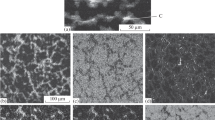Abstract
The magnetic susceptibility of Zn alloys containing 7.6–182 ppm Mn were measured in the range 1.4–4.2 K. The zero-field susceptibility can be described by a Curie-Weiss law with a concentration-independent intercept on the temperature axis, which yields a Kondo temperatureT K =0.24 K. A value for the effective number of Bohr magnetons on a Mn atom ofp=4.66 is found. Resistivity was measured on specimens containing 7.8–38 ppm Mn in the range 0.1–4.2 K. The resistivity of all specimens was proportional to logT at high temperatures but, except for the lowest concentration specimen, it showed evidence of ordering below 0.5 K. The data for the 7.8-ppm Mn specimen showed no evidence of ordering down to 0.1 K, and could be fitted to the formula of Hamann. Allowing for potential scattering, the resistivity at 0 K is found to be 45 µΘ · cm/at. % Mn. This value is in agreement withd-wave unitarity limit when corrected for the appreciable deviation of the Fermi surface in zinc from a free-electron sphere.
Similar content being viewed by others
References
E. W. Collings, F. T. Hedgcock, and Y. Muto,Phys. Rev. 134, A1521 (1964).
G. Boato, G. Gallinaro, and C. Rizzuto,Phys. Rev. 148, 353 (1966).
Y. Muto, Y. Tarawa, Y. Shibirya, and T. Fukuroi,J. Phys. Soc. Japan 14, 380 (1959).
M. D. Daybell and W. A. Steyert,Rev. Mod. Phys. 40, 380 (1968).
A. J. Heeger, inSolid State Physics, F. Seitz and D. Turnbull, eds. (Academic Press, New York, 1969), Vol. 23.
G. Boato, M. Bugo, and C. Rizzuto,Nuovo Cimento 45, 226 (1966).
See, for example, C. Kittel,Introduction to Solid State Physics, 3 ed. (John Wiley & Sons, New York, 1968), p. 429.
J. L. Tholence and R. Tournier,Phys. Rev. Letters 25, 867 (1970).
J. C. Wheatley, O. E. Vilches, and W. R. Abel,Physics 4, 1 (1968).
W. C. Black, Jr., W. R. Roach, and J. C. Wheatley,Rev. Sci. Instr. 35, 587 (1964).
R. P. Hudson and R. S. Kaeser,Physics 3, 95 (1967).
D. McLachlan, thesis, Rutgers University, 1964.
L. D. Landau and E. M. Lifshitz,Electrodynamics of Continuous Media (Addison-Wesley, Reading, Mass., 1960), p. 194.
Handbook of Chemistry and Physics, 46th ed., R. C. Weast, ed. (The Chemical Rubber Co., Cleveland, 1965–6.
K. Yoshida and A. Okijii,Progr. Theoret. Phys. (Kyoto)34, 505 (1965); H. Miwa,Progr. Theoret. Phys. (Kyoto) 34, 1040 (1965); D. J. Scalapino,Phys. Rev. Letters 16, 937 (1966).
J. W. Loram, T. E. Whall, and P. J. Ford,Phys. Rev. B2, 857 (1970).
D. R. Hamann,Phys. Rev. 158, 570 (1967).
See, for example, J. Kondo, inSolid State Physics, F. Seitz and D. Turnbull, eds. (Academic Press, New York, 1969), Vol. 23. Also, K. H. Fischer, inProceedings of the Eleventh International Conference on Low Temperature Physics, J. F. Allen, D. M. Finlayson, and D. M. McCall, eds. (University of St. Andrews Printing Office, St. Andrews, Scotland, 1969), p. 1234.
J. R. Schrieffer,J. Appl. Phys. 38, 1143 (1967).
E. Fawcett,J. Chem. Phys. Solids 18, 320 (1961).
J. D. Marsh,Phys. Letters 33A, 207 (1970).
P. J. Ford, C. Rizzuto, E. Salmoni, and P. Zani,J. Phys. 32, C1–221 (1971).
Author information
Authors and Affiliations
Additional information
Research supported by the National Science Foundation. Based in part on a Ph.D. thesis by R. S. Newrock submitted to the Graduate Faculty of Rutgers University.
Rights and permissions
About this article
Cite this article
Newrock, R.S., Serin, B., Vig, J. et al. The Kondo effect inZnMn. J Low Temp Phys 5, 701–710 (1971). https://doi.org/10.1007/BF00628418
Received:
Issue Date:
DOI: https://doi.org/10.1007/BF00628418




